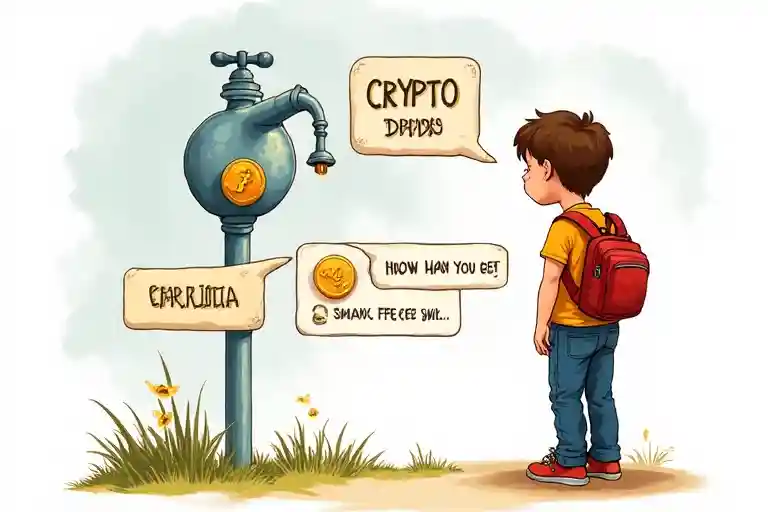Alright, let’s get straight to it! You’ve probably heard “crypto” buzzing around everywhere, maybe seen some TikToks about people making bank (or losing it!), and then BAM! Someone mentions a “crypto faucet.” Sounds kinda weird, right? Like, is it a leaky tap for Bitcoin? (Spoiler: not exactly, but you’re not far off!) If you’re scratching your head wondering about the faucet crypto meaning, you’re in the PERFECT place. I was pretty confused at first too, thinking it was some super complex tech thing. But guess what? It’s way more straightforward than you might think, though there are definitely some things you NEED to know before diving in, especially as a teen. We’re going to break down what crypto faucets are, how they *actually* work, if they’re even worth your precious screen time, the big question of legality, and how these sites even make money. Plus, we’ll explore how to use them safely and check out some alternatives. Get ready, because understanding the faucet crypto meaning could be your first step into the (sometimes wild) world of cryptocurrency, and we’ll do it with REAL talk, no fluff. Last updated: June 2025.
Before we jump in, if you’re looking for more ways to explore the crypto world, you might find our guide on crypto faucets to earn free crypto super helpful, or perhaps how to earn crypto coin free fast. These can give you a broader picture of the landscape!
What is the Real Purpose of a Faucet in Crypto?
Okay, so what’s the deal with the faucet crypto meaning? Imagine a tap that, instead of water, drips tiny, tiny amounts of cryptocurrency. That’s essentially a crypto faucet! These are websites or apps that give out small quantities of specific cryptocurrencies (like a fraction of a Bitcoin, often called satoshis, or other altcoins) to users for free. Think of it like those free samples you get at the mall – a little taste to get you interested. The primary purpose isn’t to make you rich overnight (sorry to burst that bubble!). Instead, they serve a few key functions in the crypto ecosystem.
First, they were originally created to introduce people to cryptocurrencies. Back when Bitcoin was new and not many folks knew about it, faucets were a way to distribute coins and get people curious. By giving away tiny bits, they encouraged newbies to download a crypto wallet, learn how to make transactions, and basically get their feet wet without any financial risk. It was all about education and adoption. Like, “Hey, try this new digital money thing, it’s on the house!” This educational aspect, understanding the faucet crypto meaning, is still a part of their appeal for newcomers. They also help increase awareness about newer or less popular cryptocurrencies. A new coin project might launch a faucet to get its tokens into more hands and generate buzz. It’s a pretty smart (and cheap) marketing tactic, if you think about it! Some also argue they help with network testing by generating small transactions. It’s all about getting people involved and learning the ropes, one tiny drop at a time.
Getting People Familiar with Crypto
One of the biggest goals of early crypto faucets, and still a valid point for the faucet crypto meaning today, was simply to get people comfortable with the idea of digital currencies. Think about it – when Bitcoin first popped up, it was a totally alien concept to most. “Internet money? How does that even work?” Faucets provided a no-risk entry point. You could get a few satoshis, set up your first crypto earnings earn crypto free wallet, and see how transactions happened on the blockchain. It was like a digital sandbox. You could play around, make mistakes, and learn without worrying about losing your own hard-earned cash. This hands-on experience is invaluable and often more effective than just reading articles (though you’re doing great by reading this one!).
Promoting New Cryptocurrencies
Another key purpose behind the faucet crypto meaning is marketing for new or smaller cryptocurrencies. Imagine you’ve just launched a brand-new coin, “TeenCoin” (definitely made that up, but you get the concept!). How do you get humans to recognise approximately it and start using it? A TeenCoin faucet! By giving away small quantities, the developers can spread the word, encourage humans to download the unique wallet for TeenCoin, and optimistically get a network growing round it. It’s a piece like how new apps would possibly offer loose top class functions for some time to draw users. The more people keep and probably use a coin, the extra its network can develop. For users, it’s a hazard to get in at the floor floor of something new, although, actual communicate: most new coins don’t turn out to be being the subsequent Bitcoin. Still, it’s part of the dynamic crypto world. For a deeper dive into how those mechanisms work,platforms like Binance often explain crypto concepts in detail.
Are crypto faucets worth it?
This is the million-dollar query… or rather, the few-cents query! Are crypto taps truly worth your time and effort? The sincere solution: it relies upon on what you mean by using “worth it.” If you are hoping to strike it rich and buy a Lambo from tap profits, then, difficult pass. The quantities you get are normally exceptionally small – we are speaking fractions of a cent for each declare. It could take you ages, like, actually a long time, to accumulate whatever large. Think approximately how a good deal time you’ll spend clicking, solving captchas, or watching advertisements. Now, examine that to, say, doing some on line surveys or a small freelance gig. Your time is probably higher spent someplace else in case your major aim is incomes real money fast.
However, if your goal is to learn about crypto, get some hands-on experience without spending your own money, or maybe collect a few different types of lesser-known coins just for fun (like digital trading cards!), then yeah, they can have some value. It’s like those mobile games where you tap a lot for small rewards – some people find it oddly satisfying. Plus, if you happen to grab a tiny bit of a coin that *does* eventually go up in value (a big “if”!), then your micro-earnings could become slightly less micro. But don’t bank on it. It’s more about the learning and the tiny thrill than the big bucks. The true faucet crypto meaning for many is that initial, risk-free taste of digital currency.
Time vs. Reward: The Big Trade-Off
Let’s be real, the biggest factor here is your time. Most faucets require you to complete small tasks: solving a CAPTCHA, watching a short ad, clicking a button every few minutes or hours. Each task gives you a tiny reward. If you calculate the hourly “wage,” it’s often pennies, or even less. Is clicking ads for an hour to earn $0.05 worth it when you could be studying, learning a new skill, or even just chilling with friends? For most teens, probably not. This is where the “is it worth it?” debate gets personal. If you’re just fiddling on your phone anyway, maybe it’s a fun distraction. But if you’re looking for ways to earn cryptocurrency free without investment that are more substantial, faucets are pretty low on the list. It’s crucial to weigh this when considering the faucet crypto meaning in a practical sense.
The “Maybe It’ll Moon!” Hope
Okay, so there’s this tiny little voice some people have: “What if this super obscure coin I’m collecting from a faucet suddenly becomes the next big thing? What if it ‘moons’ (crypto slang for skyrocketing in price)?” It’s true that some early Bitcoin adopters got their first coins from faucets when BTC was worth pennies. If they held onto it… well, you know the story. However, this is like buying a lottery ticket. The chances are astronomically small. For every coin that sees a massive price increase, thousands fade into obscurity. So, while it’s a fun thought, don’t let the “moon hope” be your main reason for spending hours on faucets. It’s a gamble, and usually, the house (the faucet owner) benefits more.

Are crypto faucets legal?
This is a super important question, especially when you’re a teen! Generally speaking, using crypto faucets themselves is not illegal in most places, including the U.S. They are usually just websites or apps giving away tiny bits of crypto. Think of them like promotional giveaways. However, the legality can get a bit murky depending on a few things. Firstly, the specific cryptocurrency being offered could be an issue. If a faucet is distributing a coin that is later deemed an unregistered security by authorities like the SEC (Securities and Exchange Commission) in the US, there could be problems for the *operators* of the faucet, and potentially for users if there are crackdowns. Though, as a small-time user just collecting tiny amounts, your direct legal risk is usually very low.
Secondly, age restrictions are a biggie. Many platforms, including crypto exchanges you might need for a wallet, have age requirements (often 18+). While a faucet itself might not strictly check your age to give you $0.001 worth of a coin, the broader crypto ecosystem often isn’t built for unsupervised minors. Always, *always* talk to your parents or a trusted adult before diving into anything crypto-related. They can help you understand any local rules and make sure you’re staying safe. The overall faucet crypto meaning also includes understanding the responsibilities that come with handling any kind of currency, even tiny digital bits. Some countries also have stricter regulations on cryptocurrencies in general, so if you’re outside the US, it’s worth a quick check on local laws, though faucets are usually below the radar of major enforcement unless they are involved in something else shady. Reputable sources like MoonPay offer insights into how crypto works, which can indirectly help you understand the landscape.
How do crypto faucets make money?
You might be wondering, if these faucets are giving away “free” crypto, how do *they* stay in business? That’s a smart question! The faucet crypto meaning isn’t just about getting free coins; it’s also an economic model for the site owners. They aren’t just being generous out of the goodness of their hearts (usually!). Here are the main ways crypto faucets make money:
- Advertising (The BIG One): This is the primary revenue source. Faucet websites are often PACKED with ads – banner ads, pop-ups, video ads you have to watch. Every time you click an ad or even just view a page with ads, the faucet owner earns a small amount from advertisers. Your eyeballs and clicks are their product! It’s like how many free mobile games work – you play for free, but you see a ton of ads.
- Affiliate Marketing: Many faucets will link to other crypto services, like exchanges, wallets, or even other faucets. If you click through their affiliate link and sign up or make a purchase, the faucet owner gets a commission. It’s like when your favorite YouTuber has a “promo code” for a product.
- Mining: Some (often shadier) faucets might use your computer’s processing power to mine cryptocurrency while you have their site open. This is often done without clear consent and can slow down your device or use extra electricity. This is definitely a red flag – if a site makes your computer fan go BRRRRR for no reason, be cautious!
- Captchas and Surveys: The captchas you solve to prove you’re human? Sometimes faucet owners get paid tiny amounts by captcha services. Similarly, they might embed surveys from third-party providers and earn a cut when users complete them.
- Traffic Generation for Other Services: A faucet can be used to draw traffic to a larger platform the owner runs, perhaps a crypto casino, a paid game, or an exchange. The faucet is the “hook.”
So, while you’re collecting those tiny crypto drops, the faucet owners are collecting ad revenue and other income streams generated by your engagement. It’s a numbers game for them: attract enough users, and all those tiny ad earnings add up.
Faucet crypto.com login: Using Faucets with Exchanges (General Guide)
You might see terms like “Faucet crypto.com login” and wonder if major exchanges like Crypto.com run their own faucets. Generally, large, well-known exchanges like Crypto.com or Coinbase don’t operate traditional crypto faucets in the way we’ve been discussing (i.e., click-for-tiny-rewards sites). Their business model is different, focusing on trading, staking, and other financial services. For instance, learning about Coinbase learning rewards for free crypto shows a different model where you earn by learning, which is often more substantial and educational than faucets.
However, what people often mean by “Faucet crypto.com login” or similar queries is how to send the crypto they’ve earned from *third-party* faucets to their exchange wallet (like one on Crypto.com). Here’s the general idea:
Most faucets have a minimum withdrawal threshold. This means you need to accumulate a certain amount of crypto (say, 5000 satoshis) before you can transfer it out. Once you reach that threshold, you’ll go to the faucet’s withdrawal section. There, you’ll need to provide a wallet address for the specific cryptocurrency you’re withdrawing. This is where your Crypto.com (or any other exchange/wallet) account comes in. You’d log into your Crypto.com account, find the “deposit” address for that specific coin (e.g., Bitcoin, Dogecoin), copy it *very carefully*, and paste it into the faucet’s withdrawal form.
Double, triple, QUADRUPLE check that address! Sending crypto to the wrong address is like putting cash in the wrong envelope and mailing it – it’s probably gone forever. Seriously, this is *super* important. Also, be aware of withdrawal fees. Sometimes the faucet itself charges a fee, or the network transaction fee might eat up a good chunk of your tiny earnings, especially for coins like Bitcoin during busy times.
Crypto Faucet app
Yup, just like there are faucet websites, there are also Crypto Faucet app versions you can download on your phone. The idea is pretty much the same: perform small tasks, watch ads, and earn tiny bits of cryptocurrency. The appeal of an app is convenience – you can click and claim while you’re waiting for the bus, bored in a waiting room, or (let’s be honest) pretending to pay attention in a Zoom class (kidding… mostly!).
Many popular web-based faucets also have companion apps, or some services are app-exclusive. When looking for a Crypto Faucet app, the same cautions apply as with websites:
- Check Reviews: What are other users saying? Look for reviews on the app store, but also on places like Reddit or crypto forums for more unfiltered opinions. Are people actually getting paid? Are there lots of complaints about bugs or excessive ads?
- Permissions: When you install an app, see what permissions it’s asking for. Does a simple faucet app *really* need access to your contacts or microphone? If it seems sketchy, it probably is. #Sus.
- Ads, Ads, Ads: Mobile apps can be notorious for bombarding you with ads. If the user experience is just unbearable because of constant pop-ups and unskippable videos, it might not be worth the frustration for those tiny crypto crumbs.
- Battery Drain and Data Usage: Some poorly optimized apps can drain your battery or chew through your mobile data, especially if they’re heavy on ads or (worst case) doing sneaky background mining. Keep an eye on that!
For many teens, the idea of an app seems easier, but remember the core principle of the faucet crypto meaning: it’s usually very small rewards for your time. An app just makes it mobile. Some people find legitimate apps that work okay for them, but always, *always* proceed with caution and realistic expectations. Maybe try one out, see if you find it fun, but don’t expect it to be a path to riches.
Free crypto faucets
The term “Free crypto faucets” is a bit redundant because, well, the whole point of a faucet is to give out crypto for free! If a site or app is asking you to pay money to join or to receive your “free” crypto, that’s a GIANT red flag. Run away! That’s not a faucet; that’s likely a scam. Legit Free crypto faucets make their money through advertising and other methods we discussed earlier, not by charging their users directly for the “privilege” of earning micro-amounts.
When you’re hunting for these, you’ll find faucets for all sorts of cryptocurrencies, not just Bitcoin. There are Ethereum faucets, Litecoin faucets, Dogecoin faucets (much wow!), and faucets for many newer or lesser-known altcoins. This can be a fun way to diversify a tiny portfolio if you’re just collecting for kicks. Some dedicated crypto enthusiasts like to collect from various Free crypto faucets to get a wide range of different coins. There are even “rotator” sites that help you quickly switch between multiple faucets to maximize claims, but again, think about the time commitment!
Are All “Free” Faucets Safe?
Heck no! Just because it says “free” doesn’t mean it’s safe or legitimate. The internet is a wild place, and the crypto world can be even wilder. Some so-called “faucets” might be phishing sites trying to steal your login information for other services (like your actual crypto exchange account – yikes!). Others might trick you into downloading malware. And some just… don’t pay out. You spend weeks clicking, reach the withdrawal limit, and poof! Nothing. Or the site disappears. It’s a classic “if it sounds too good to be true…” scenario. The best defense? Stick to well-known faucets (if you can find consensus on which those are – discussion forums can help) and never, *ever* give out your private keys or sensitive personal information. And remember, “free” often just means you’re paying with your time and data.

Finding the Best Free Bitcoin Faucet Websites
Okay, so you understand the faucet crypto meaning, you know the rewards are small, but you’re still curious and want to try finding some “Free Bitcoin Faucet Websites.” How do you even find them, and which ones are, relatively speaking, “better”? First off, a direct search on Google for “Free Bitcoin Faucet Websites” will give you tons of results, including lists and review sites. Some crypto blogs and forums also maintain lists of faucets they’ve tested. One example of such a blog is Koinly’s blog which discusses various faucets.
When evaluating these websites, here’s what to look for:
- Reputation & Reviews: What are people saying online (e.g., on Reddit’s r/beermoney or crypto-specific forums)? Look for recent payment proofs if possible. Older reviews might be outdated as faucets can change owners or go offline.
- Claim Amount & Timer: How much do they offer per claim, and how often can you claim? Some let you claim every 5 minutes, others every hour. More frequent isn’t always better if the amount is ridiculously tiny.
- Minimum Withdrawal: How much do you need to accumulate before you can withdraw? A very high minimum means you’ll be clicking for a *long* time. Lower is generally better, assuming the withdrawal fees aren’t crazy.
- Withdrawal Methods & Fees: Do they pay directly to your Bitcoin wallet, or do they use a micropayment wallet service (like FaucetPay or Cointiply)? Check the fees associated with withdrawals – sometimes they can eat up a significant portion of your earnings.
- User Experience: Is the site usable, or is it an absolute nightmare of aggressive pop-ups, misleading buttons, and endless captchas? If it’s super annoying, it’s probably not worth it.
- Longevity: How long has the faucet been around? While not a guarantee, faucets that have been operating for a while *might* be more stable, but even old ones can disappear.
Remember, even the “best” Bitcoin faucets are still just offering tiny amounts. It’s more like a hobby than a serious earning method. And again, for teens, parental guidance is key, especially when setting up wallets and dealing with withdrawals. If you’re keen on getting into crypto without spending, exploring options like making money with cryptocurrency for beginners through learning platforms might be a more rewarding path in the long run.
Safety First! Staying Secure with the faucet crypto meaning
This is SO important, especially for teens. The crypto world has its share of scams and sketchy stuff, and faucets are no exception. Understanding the faucet crypto meaning also means understanding the risks. Here’s how to stay safer:
- Parental Guidance, For Real: I’ve said it before, I’ll say it again. Talk to your parents or a trusted adult *before* you start messing with crypto faucets or any crypto. They can help you spot red flags and make sure you’re not accidentally breaking any rules or putting yourself at risk. This isn’t like, “Mom, can I play this game?” It involves potential (even if tiny) financial stuff.
- Strong, Unique Passwords: Use a different, strong password for every faucet site and for your crypto wallet. Don’t reuse passwords! If one site gets hacked, you don’t want them getting into everything else. Password managers can be a lifesaver here.
- Beware of Phishing: Scammers might create fake faucet sites that look like real ones to steal your login info or private keys. Always double-check the website URL. Never, *ever* share your private keys for your main crypto wallet with *anyone* or any site. Your keys are like the PIN to your bank account, but even more critical in crypto.
- Too Good To Be True? It Probably Is: If a faucet promises huge payouts for little work, it’s almost certainly a scam. “Earn 1 Bitcoin a day by clicking here!” Yeah, no. That’s not how the faucet crypto meaning works in reality.
- Don’t Download Sketchy Software: Some “faucets” might ask you to download software or browser extensions. Be *extremely* cautious. These could contain malware, viruses, or keyloggers. Stick to reputable browser-based faucets if you can, or well-reviewed apps from official app stores (and even then, be careful).
- Use a Separate Email: Consider using a secondary email address for signing up to faucets. This can help keep your main inbox clean from potential spam.
- Antivirus and Anti-Malware: Make sure your computer or phone has up-to-date security software. It’s a good general practice anyway!
- Microwallets vs. Direct Wallets: Some faucets pay out to special “microwallet” services that accumulate your earnings from multiple faucets before sending a larger amount to your main wallet. These can be convenient but research the microwallet’s reputation too. Direct-to-your-own-wallet is often preferred for security once you meet withdrawal minimums, but transaction fees can be higher.
Think of it like this: you wouldn’t just walk up to a random stranger offering “free money” on the street without being a little suspicious, right? Apply that same common sense online. Stay frosty, fam!
Comparing Faucet Activities: What’s Your Time Worth?
Not all faucet interactions are the same. Here’s a quick look at common tasks and what they generally entail, helping you understand the practical side of the faucet crypto meaning:
| Activity Type | Typical Task | Time Commitment (per claim) | Potential Reward (per claim) | Teen “Fun” Factor |
|---|---|---|---|---|
| Basic Claim | Solve a CAPTCHA, click a button | 10-30 seconds | Extremely Low (fractions of a cent) | Low – can get boring fast (like, “is this it?” boring) |
| PTC (Paid-to-Click) Ads | View an advertiser’s website for X seconds | 15-60 seconds | Very Low | Low – basically ad watching |
| Shortlinks | Navigate through multiple ad-filled pages | 1-3 minutes | Low (slightly higher than basic claim but more annoying) | Very Low – often frustrating with pop-ups |
| Offerwalls / Surveys | Complete surveys, sign up for offers, download apps | 5-30+ minutes | Low to Medium (can be higher, but so is time/data risk) | Medium – if you like surveys, but beware data privacy |
| Faucet Games | Play simple browser/app games | Varies | Usually Low (rewards tied to game progress/ad views) | Medium to High – if the game is actually fun (rarely a AAA title, lol) |
Looking at this, you can see it’s a trade-off. The “easiest” tasks pay the least. The ones that *might* pay a tiny bit more often require more time, more personal data, or navigating a minefield of ads. This table should give you a clearer picture beyond just the term faucet crypto meaning and into the “what am I actually doing?” part. Is clicking a button every 15 minutes for $0.0001 how you want to spend your afternoon? Maybe for a bit, just to see how it works. But long-term? Probs not. Remember the “Stonks” meme? Faucet earnings are usually the opposite of stonks, more like “Stinks” if you’re not careful with your time. This isn’t financial advice, just, ya know, friendly real talk!
Conclusion
So, there you have it – the lowdown on the faucet crypto meaning, especially for you teens out there! We’ve seen that crypto faucets are basically websites or apps that drip out tiny amounts of cryptocurrency in exchange for completing small tasks. Their original purpose was to introduce people to crypto and promote new coins, and they still serve that role for some newbies. They make money primarily through advertising. Are they worth it? For getting rich, definitely not. For learning the absolute basics of crypto in a risk-free (from a monetary investment standpoint) way, maybe for a little bit. But the time commitment for very, *very* small rewards is a huge factor.
The most important takeaways? Always prioritize your safety online. Talk to your parents, use strong passwords, be super wary of scams, and never expect to earn significant money from them. The real value, if any, is in the education and the initial exposure to how crypto transactions work. If you’re serious about exploring earning money from cryptocurrency as a teen, there are likely more efficient and rewarding avenues out there, like learning platforms that offer crypto for completing courses.
What do YOU think about crypto faucets now that you understand the faucet crypto meaning? Drop a comment below and share your thoughts or experiences! And hey, if you found this article helpful, why not share it with your friends on TikTok or Instagram? Let’s spread the knowledge (and the safety tips!).
Stay Updated! The crypto world changes FAST. New platforms emerge, and regulations can shift. Keep checking back with us at zana.website for the latest guides and insights for teens navigating the digital world!
Frequently Asked Questions
1. What is the purpose of faucet in crypto?
The main purpose of a crypto faucet is to introduce new users to cryptocurrencies by giving away small amounts for free. They also help promote new or lesser-known coins and can encourage people to learn about crypto wallets and transactions without financial risk. Essentially, they’re a promotional and educational tool for the crypto space.
2. Are crypto faucets worth it?
For making significant money, crypto faucets are generally not worth the time, as rewards are extremely small. However, they can be useful for learning the basics of crypto, getting hands-on experience with transactions, or collecting tiny amounts of different coins for fun, with minimal financial risk. It’s more about education than earning.
3. Are crypto faucets legal?
Using crypto faucets is generally legal in most places for users. However, always be mindful of age restrictions on related platforms (like exchanges often requiring users to be 18+). The legality can also depend on the specific cryptocurrency being distributed and local regulations. Always consult with a parent or guardian.
4. How do crypto faucets make money?
Crypto faucets primarily make money through advertising displayed on their website or app. They also earn from affiliate marketing (referring users to other services), sometimes through users completing surveys or offers, and occasionally (though less desirably) through things like background crypto mining on a user’s device.
5. What is the primary purpose of faucet in cryptocurrency ecosystem?
The primary purpose of a faucet in the cryptocurrency ecosystem is to distribute small amounts of crypto to users, primarily for educational reasons and to promote wider adoption of specific coins. They help newcomers get acquainted with crypto wallets and transactions in a low-risk environment and assist new coin projects with initial distribution.









